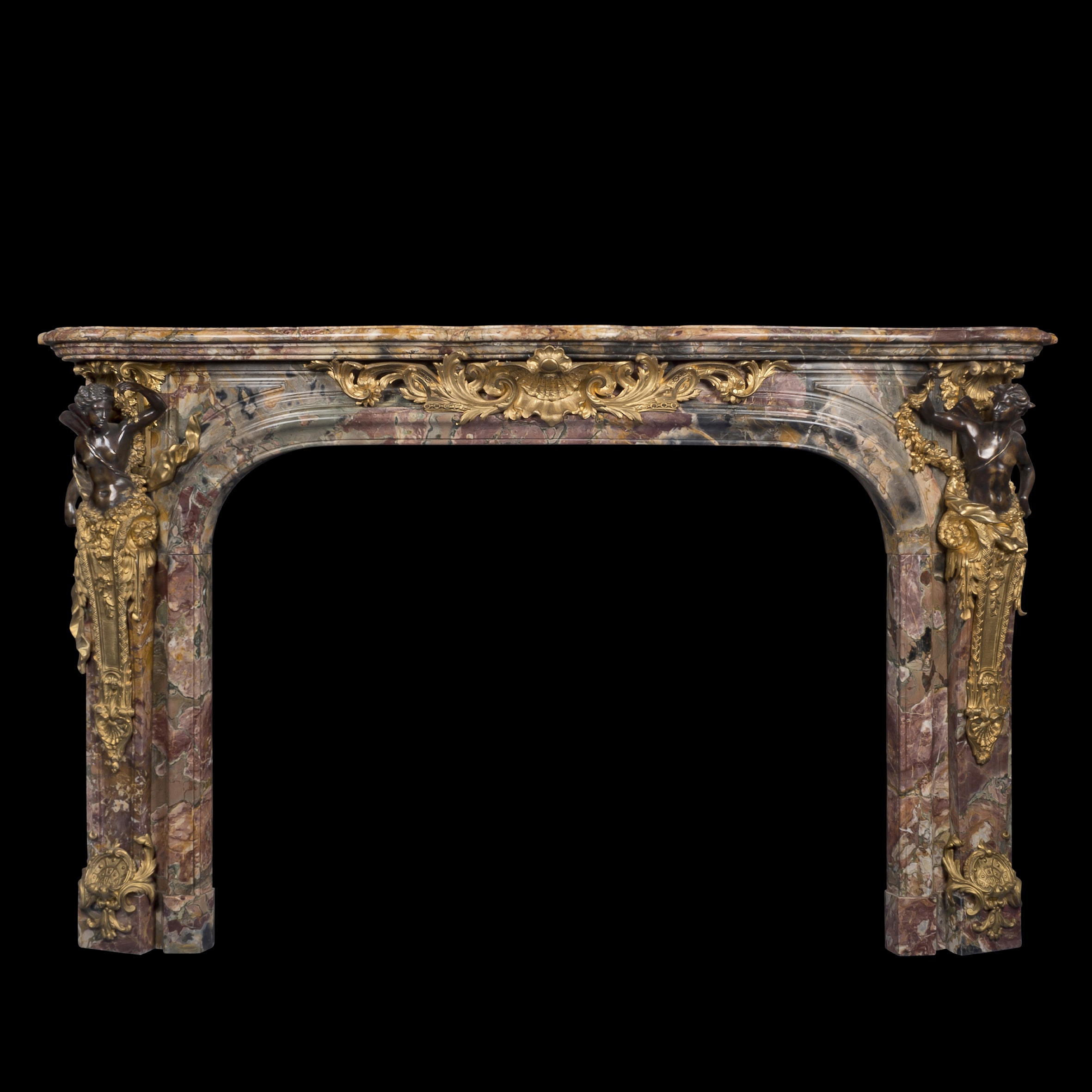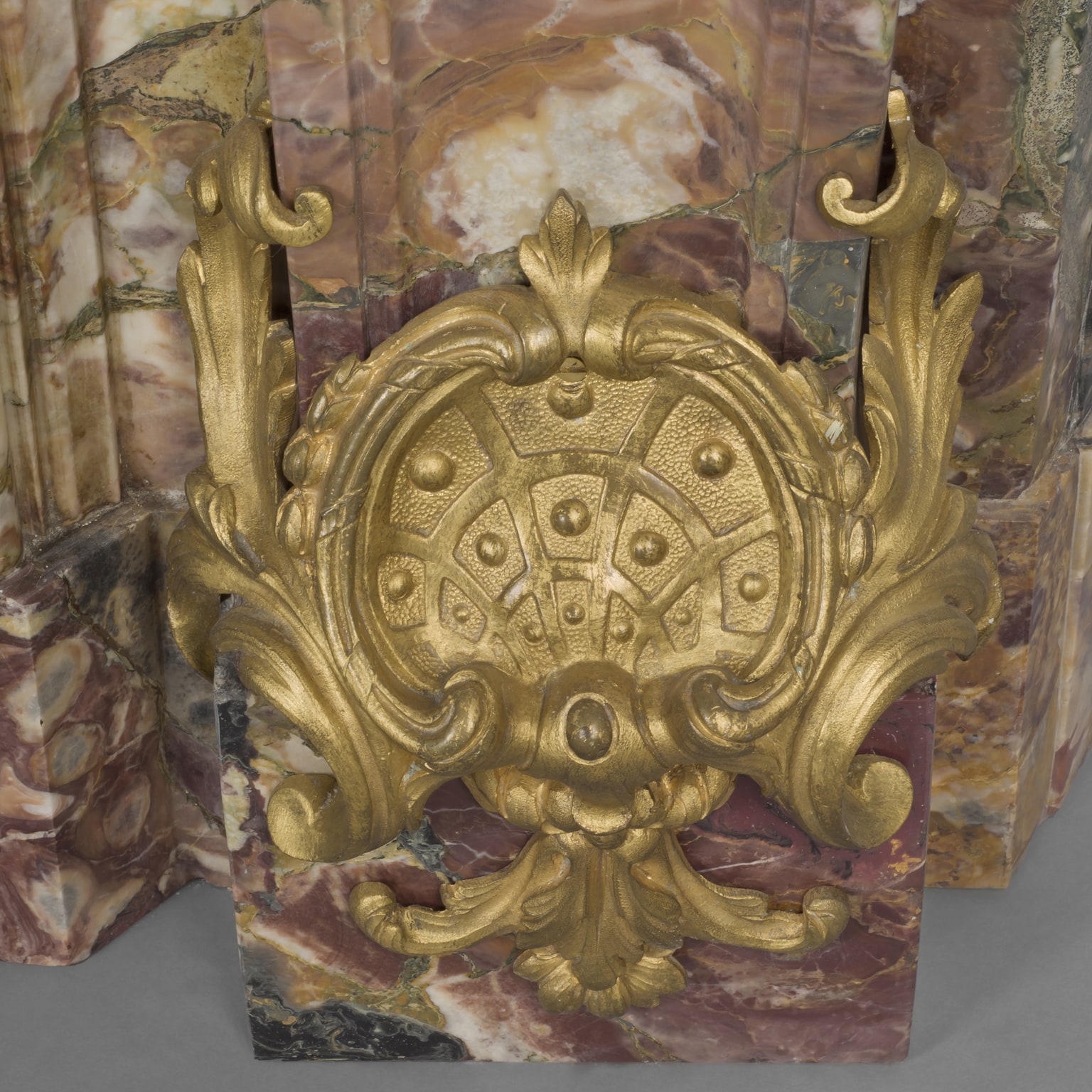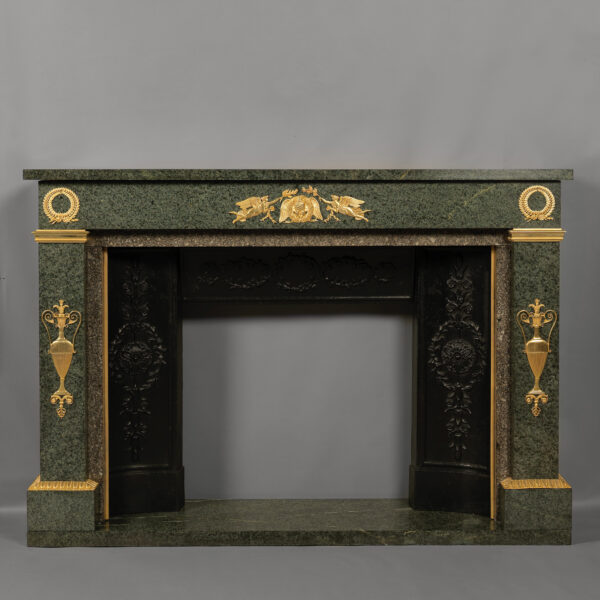在Jacques Caffieri之后
一个精美的路易十五风格的壁炉
£110,000
A Fine Louis XV Style Gilt and Patinated Bronze Mounted Marble Fireplace With Gilt Bronze Mounts Depicting Flora and Zephyr, After the Model By Verberckt...
尺寸
Height: 127 cm (50 in)Width: 208 cm (82 in)
Depth: 46 cm (19 in)
描述
A Fine Louis XV Style Gilt and Patinated Bronze Mounted Marble Fireplace With Gilt Bronze Mounts Depicting Flora and Zephyr, After the Model By Verberckt and Caffieri at Versailles.
This rare and impressive fireplace has a serpentine Breccia Pernice mantle over an arched lintel centering on a gilt-bronze coquille mount, issuing scrolling acanthus and foliate vines. The jambs are mounted with patinated bronze Herm figures holding aloft floral vines above tapering gilt-bronze supports cast with rosettes and scrolling vines. The jambs are raised on a stepped base with gilt-bronze foliate and cartouche mounts.
The fireplace is based on a chimney-piece by Jacques Verberckt with gilt bronze mounts by Jacques Caffiéri, supplied for the bedchamber of the Dauphin at Versailles in 1747. A very similar nineteenth century example, with gilt-bronze and dark patinated bronze figures of Flora and Zephyr to the jambs, is in the Wallace Collection, Hertford House, London. Another example, dating to 1860, was installed in the salon d’Apollon at the Tuileries. A similar fire surround was also installed in the Kings’s Study at Ras al-Tin Palace in Egypt, the interiors furnished by Francois Linke – see C. Payne, ‘Francois Linke: The Belle Epoque of French Furniture’, Woodbridge, 2003, p. 289.
Jacques Verberckt (1704-1771) was a sculptor and decorator of Flemish French origin. Born in Antwerp to a family of silversmiths, he moved to Paris in 1716 and took up a position in the Batiments du Roi, as an ornamental sculptor and virtuoso carver. He gained favour with the Premier Architecte du Roi, Jacques Gabriel V, and his son Ange-Jacques Gabriel and worked on many of the royal chateaux. He was approved (agréé) by the Académie Royale in 1733.
Jacques Caffieri (1678-1755) was the tenth son of Phillippe Caffieri (1634-1716), who emigrated from Naples at the request of Cardinal Mazarin to decorate the interiors at Versailles. He was elected to the Académie de Sainte-Luc as a sculptor, and thus created many of the original designs that were proprietary models of his foundry.
From 1736, when he was appointed fondeur-ciseleur des Batiments du Roi, Caffieri remained in the employ of the French Crown.
日期
约1860年
原产地
法国
中型
Marble, Gilt & Patinated Bronze
Jacques Caffieri (1678-1755) a sculptor famous for his works in bronze, was the son of Philippe Caffieri (1634-1716), who emigrated from Naples to Paris at the request of Cardinal Mazarin to decorate the interiors at Versailles. He was elected to the Académie de Saint-Luc as a sculptor, and thus created many of the original designs that were proprietary models of his foundry.
Jacques was received as a maître fondeur-ciseleur by 1715, the date of his first known work, a design for a pall for the Corporation des Fondeurs-Ciseleurs, one of the two Parisian guilds that oversaw works cast in metal.
Caffieri was appointed fondeur-ciseleur des Bâtiments du Roi in 1736. Following this, a large proportion of his best work as a designer and chaser in bronze was executed for commissions to the crown at Versailles, Fontainebleau, Marly, Compiègne, Choisy and the Château de La Muette. In fact, he executed so much work for the crown that they were forever in his debt, still owing him money at his death.
In addition to these royal commissions from his workshop in rue des Canettes came an amazing amount of work, chiefly in the shape of gilt-bronze furniture mounts used by the best ébénistes of Paris, with whom he worked closely. Little of his production was ordinary and an astonishingly large proportion of it is now famous. Caffieri was also known for his production of gilt-bronze cases for clocks.
In 1740, Caffieri’s wife purchased a royal privilege, which allowed the Caffieri workshop to gild bronze as well as cast it within the same workshop; ordinarily the processes were divided between two Parisian corporations, jealous of their jurisdictions, the fondeurs-ciseleurs and the ciseleurs-doreurs. This privilege further set Caffieri apart from his rivals.
Bibliography:
Ottomeyer, Hans & Proschel, Peter. Vergoldete Bronzen, Vol I, Klinkhardt & Biermann, (Munich), 1986; p 137, pl. 2.10.3.
Verlet, Pierre. Les Bronzes Dorés Français du XVIIIe siècle, (France), 1987; p. 288, pl. 324.

















 印刷品
印刷品


